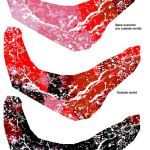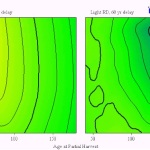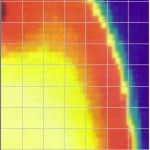Mountain Pine Beetle, Western Root Disease and Dwarf Mistletoe: extensions for FVS/Prognosis
Mountain Pine Beetle
 ESSA, in cooperation with scientists and others of the USFS, spent several years developing the Westwide Pine Beetle Model (WWPBM), which simulates the impact of mountain pine beetle (Dendroctonus ponderosae Hopkins), western pine beetle (Dendroctonus brevicomis LeConte), and Ips spp. on western pine tree species.
ESSA, in cooperation with scientists and others of the USFS, spent several years developing the Westwide Pine Beetle Model (WWPBM), which simulates the impact of mountain pine beetle (Dendroctonus ponderosae Hopkins), western pine beetle (Dendroctonus brevicomis LeConte), and Ips spp. on western pine tree species.
The model is a multi-stand, landscape-level model and operates as an extension of the FVS/Prognosis stand projection model coupled with the multi-stand FVS Parallel Processing Extension (PPE).
For more information, see:
- Modelling Mountain Pine Beetle in the Chilcotin.
- Incorporating MPB impacts at the stand and landscape level, in Hawkes et al. 2005
- Simulating root disease impacts in the Kamloops and Nelson Forest Regions
The Western Root Disease Model (WRDM)
 This extension to FVS/Prognosis is a non-spatial model that simulates the impacts of Armillaria mellea, Phellinus weiri, and S- and P-type Annosus on the growth and mortality of trees in a stand.
This extension to FVS/Prognosis is a non-spatial model that simulates the impacts of Armillaria mellea, Phellinus weiri, and S- and P-type Annosus on the growth and mortality of trees in a stand.
Stand and disease management options, such as clear cuts, partial cutting, planting, stumping, or borax application can affect the spread of the infection. The model simulates the spread of disease patches (“centers”) within the stand. The impact of the disease in the stand is highly dependent on the species composition of the stand, as well as the size and density of the trees, as each tree species reacts differently to infection; some species, such as Douglas-fir, are highly susceptible while others are immune.
For more information, see:
Dwarf Mistletoe Model
 In collaboration with scientists from the USDA Forest Service we developed a spatial statistical model of dwarf mistletoe spread and intensification, linking the model to the Dwarf Mistletoe Model extension of the Forest Vegetation Simulator.
In collaboration with scientists from the USDA Forest Service we developed a spatial statistical model of dwarf mistletoe spread and intensification, linking the model to the Dwarf Mistletoe Model extension of the Forest Vegetation Simulator.
For more information, see:
- Modelling dwarf mistletoe at three scales: life history, ballistics and contagion.
- USDA Forest Service Dwarf Mistletoe Model
